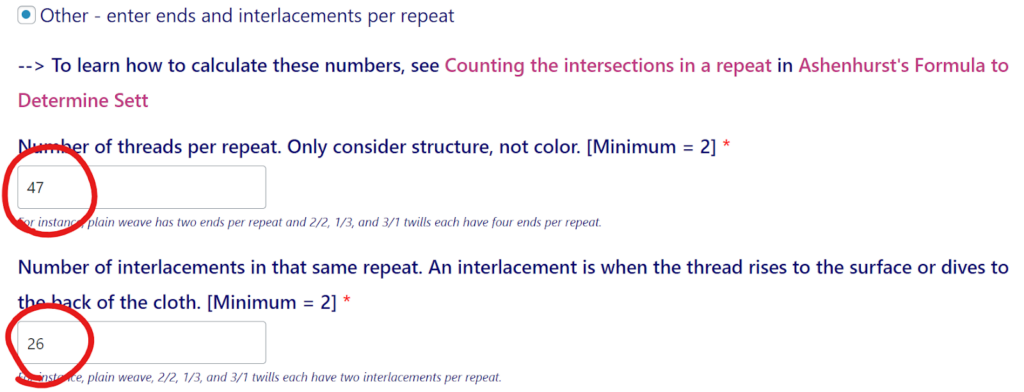Sett charts exist for plain weave and twill, but what if your draft is neither? Enter Ashenhurst’s Rule, which enables you to calculate sett for any draft, in any yarn.
In this blog post, we’ll walk you through several ways to come up with the right sett, from rough estimate to detailed calculations using Ashenhurst’s Rule. To help you understand the thought process, we’ll talk through a real-life example.
At a recent Peer Support session, Sharan Gibson asked for help figuring out a sett to use for Draft #79662 from Handweaving.net, pictured below:

She had seen pictures of a project someone else had woven in this draft, using silk at a sett of 24. Sharan will be using 5/2 mercerized cotton for her project, for which a sett of 18 is recommended for twill. She wanted to know if using the recommended twill sett is a good idea, considering that a lot of this fabric isn’t very twilly.
We talked about a couple of quick and dirty ways to make a decision about starting sett, but I promised Sharan a full explanation of how I’d verify those quick and dirty answers by using the Draft Editor and the Ashenhurst calculator (both of these tools are available to members on the Handweaving Academy website). That’s what you’ll find below.
Quick and dirty decision making
The drawdown above is half twill. More importantly, although the threading is clearly divided into sections, all of those sections weave twill at some point. Likewise, although the treadling is divided into sections, all of those sections weave twill at some point. In particular, the parts of the threading and treadling that don’t look like twill actually DO produce twill when used together.
All of this to say: although those regions of the drawdown without diamonds don’t look like twill and don’t have any of the diagonally arranged floats characteristic of twill, they’re at least … “twill adjacent”? They’re closely related to twill, and as a result a twill sett should be about right.
If Sharan can find out exactly which silk was used for the fabric she admired, she’ll be able to verify whether the recommended twill sett is a good place to start for her project. If 24 EPI is the recommended twill sett for the silk that was used, it stands to reason that using the recommended twill sett for her 5/2 cotton will work just as well. If 24 is much closer or much looser than the recommended twill sett for the silk yarn used in the inspiration piece, then Sharan will probably need a similarly closer or looser sett for her 5/2. Ratios are your friend here!
Without knowing what silk was used, however, there’s no way to verify the sett by comparison. Instead, we can use Ashenhurst’s rule to determine sett.
Doing the math with Ashenhurst’s rule
In order to use Ashenhurst’s rule for sett (discussed in our previous blog post), we need to know four things:
- The yards per pound of the yarn,
- Whether it’s dense or lofty,
- How many ends there are per repeat, and
- How many interlacements or intersections there are per repeat.
The first three things are easy to determine. The last one is trickier.
Yards per pound; Dense or lofty?
5/2 cotton has 2100 yards per pound. You can find that information in our Cotton Yarn: A Weaver’s Guide class, or look it up online. (Members can also work it out with our “Calculate yards per pound from cotton count” calculator.)
Density matters because “lofty” yarns (yarns that have a lot of squish, like a woolen spun wool) are thicker relative to their weight than dense yarns. This factor affects the diameter of the yarn.
For diameter per inch, then, you want to use the yards per pound times the density factor. For lofty yarns, the density factor is 0.84, and for dense yarns, the density factor is 0.9.
Ends per repeat
To figure out ends per repeat, let’s head to our Draft Editor (or other weaving software). Here’s the complete Draft #79662…

…but it’s the non-twilly sections we want to know about, so I deleted threads until I got down to just one repeat of the fabric I’m trying to figure out a good sett for:

This threading and treadling are both mirrored around a central pivot point so I could cut the repeat in half in both directions. That won’t always be the case in other drafts, though, so for this demo I’ll work with this entire section.
As you can see from the numbers above the threading grid, this repeat has 47 ends.
Interlacements (aka Intersections) per repeat
This is the tricky bit. What we need to know is how many times across this repeat the weft thread changes face between the top and bottom of the cloth. Fortunately, that’s really easy to figure out.
Let’s look at just the first weft pick:

Note that I’ve put the Draft Editor into “warp struct” mode so that I see solid areas of black and white in the drawdown. The black areas are where the warp floats under the cloth and the white areas are where it floats on top. What we want to know is how many times the weft switches from black to white or vice versa.
To find this number, all we need to do is to count the number of black and white areas across the repeat and then subtract 1.

This pick has 27 distinct areas of black or white across its width. That means there are 27-1 = 26 places where the weft changes from top to bottom or vice versa.
In other words, there are 26 interlacements within this repeat. Interlacements per repeat, or IPR, is the number we needed, so now we have all the numbers we need to calculate the sett using Ashenhurst’s Rule.
To the calculator!
If you’re a member, then you have access to our Ashenhurst Calculator, it’s easy as pie. You put the numbers we’ve come up with into the Ashenhurst calculator, like so…


If you’re not a member, you can calculate it by hand using the equation for Ashenhurst’s Rule:

“D” is the yarn diameter, and is the density factor times the square root of yards per pound.
Now, S is the maximum sett you can achieve with that yarn. That is not the sett you want to actually use, unless you want a warp-faced fabric that is stiff and hard to beat in.
Using percentages with Ashenhurst’s Rule to get the hand you want
If your goal is a stable fabric that still has some drape, 75% of S is the generally accepted recommendation. I often find 75% to be too dense for my tastes, and prefer something more like 70%. If I want dense fabric that still has some drape, I might go as high as 80%.
If your goal is an open, gauzy fabric with a lot of drape (but less stability!), choose something lower than 70%.
If your goal is dense, firm, upholstery fabric, then 90% is the usual suggestion.
If you’re weaving with a lofty woolen spun animal hair fiber that you want to full, use a lower percentage than normally indicated for the purpose of the fabric. The extra space will give the fibers room to knit together.
Back to our example
Plugging the numbers into our Ashenhurst Calculator (or calculating by hand using Ashenhurst’s Rule)…
…we get a suggested sett of 19 for stable cloth:

That’s very close to the recommended sett for twill, so we’ve got the verification we were looking for!
Don’t forget that the complete draft combines these regions with regular twill, for which we’re assuming a sett of 18 EPI will work.
We could average the two together to get a recommended sett of 18.5, but sleying that would be a lot of bother no matter what reeds Sharan has available, and there’s very little to be gained by such minute differences in sett. She might as well just go with the 18 she had originally planned on – it should work fine!
More effort for more accuracy – maybe!
Hang on a sec, though. We came up with 26 interlacements per repeat (IPR) by looking at the first pick of the treadling. What if we’d decided to look at the second pick instead?
Here’s what the drawdown of just that pick looks like:

Here’s the pick on its own so it’s easier to count interlacements:

If we count the black and white sections of this pick, we get 27 again, which means we still have 27-1 = 26 interlacements per repeat. Things look good!
Now let’s check the third pick:


THIS pick has only 19 black and white sections, and therefore 19-1 = 18 interlacements per repeat. If we put 18 into Ashenhurst’s Rule (or our Ashenhurst Calculator) instead of 26, it gives us a recommended sett of 21, not 19!
So some picks want a sett of 21 while other picks want a sett of 19. What do we do about that?
You’ve got a few options to choose from, in order here from least effort and least accurate to most effort and most accurate:
- Don’t worry about it – just choose one of the picks and use its IPR.
- Work out the IPR for each treadle and average those together.
- Work out the IPR for each pick in the repeat and average those together.
There’s no right or wrong choice! It just depends on how much effort you’re willing to expend vs. how accurate you need the results to be. If a ballpark number is good enough, then there’s nothing to be gained by working out every single pick of a long treadling repeat. More to the point, doing all the extra legwork might just land you right back where you started anyway.
For the sake of completion, let’s compare the results of all three approaches.
Just choose one pick
We’ve already done this, and gotten two different IPRs: 26, and 18. The recommended setts for each are 19, and 21.
Work out the IPR for each treadle and average
We’ve worked out the IPR for Treadles 1, 2, and 3 (26, 26, and 18 respectively). Now we need to do Treadles 4-8.
Treadle 4 has 29 black and white sections and therefore an IPR of 28:

Treadle 5 has 21 black and white sections and therefore an IPR of 20:

Treadle 6 has 21 black and white sections and therefore an IPR of 20:

Treadle 7 has 29 black and white sections and therefore an IPR of 28:

Treadle 8 has 19 black and white sections and therefore an IPR of 18:

If we add up the IPR for all eight treadles and divide by 8, we’ll see that the average IPR is 23.
| Treadle | IPR |
| 1 | 26 |
| 2 | 26 |
| 3 | 18 |
| 4 | 28 |
| 5 | 20 |
| 6 | 20 |
| 7 | 28 |
| 8 | 18 |
| total | 184 |
| average | 23 |
If we put this new average IPR into Ashenhurst’s Rule, the recommended sett we get is … 19. Right back where we started.
Work out the IPR for each pick in the repeat
If the treadling of our cloth used each of the treadles an equal amount, then averaging the IPR for each treadle would tell us the whole story. Look at our treadling, though:

The first treadle is only used twice: for the very first and very last pick. The eighth treadle is only used once! Treadle 4, on the other hand, is used 10 times during the repeat. Obviously, giving all three treadles the same “weight” in the average might not give us the most accurate answer.
To see if it does, let’s weight the calculation so that each treadle’s IPR is added in once for each time it’s actually used. If you count up the number of times each treadle is used in the above treadling, you’ll get this:
| Treadle | IPR | Times used | Weighted IPR |
| 1 | 26 | 2 | 52 |
| 2 | 26 | 4 | 104 |
| 3 | 18 | 8 | 144 |
| 4 | 28 | 10 | 280 |
| 5 | 20 | 10 | 200 |
| 6 | 20 | 8 | 160 |
| 7 | 28 | 4 | 112 |
| 8 | 18 | 1 | 18 |
| total | 184 | 47 | 1070 |
| average | 23 | 22.8 |
For the weighted average, I multiplied the IPR of each treadle by the number of times it’s used, added all of those values up, and then divided it by the total number of picks in the repeat. In other words, I added up the IPR for each of the 47 picks in the treadling repeat, and then divided that total by 47 to get the average. (1070 divided by 47 = 22.8)
As you can see, the pick-by-pick average is almost identical to the treadle-by-treadle one, so all that extra effort didn’t make a difference in this case. It might make a difference in a different situation, where the interlacement is markedly different from one treadle to the next or where one treadle is used much more often than the others.
Sett calculations in a nutshell with Ashenhurst’s Rule
To use Ashenhurst’s rule to work out an appropriate sett, you need to know the yards per pound of your yarn, whether it’s dense or lofty, and how many ends there are in a threading repeat. Those are all straightforward.
You also need to know the interlacements per repeat, which is easy to figure out for an individual pick by counting the number of black and white areas across the row and subtracting 1.
If you’re a member, simply plug those four numbers into our Ashenhurst calculator, and presto: instant sett recommendation.
Or, if you’re not a member, plug those numbers into the Ashenhurst formula, and do some work with a calculator to get the right result.
A lot of the time, that’s all you need to do. JOB DONE.
If you want to be extra careful, work out the IPR for each treadle and use the average in the calculator.
If your structure has really different amounts of interlacements from pick to pick and the “lots of interlacement” and “little interlacement” picks aren’t fairly equal in number, then you might want to work out the IPR for every single pick in the repeat and average that out. You might get a different, more accurate number, or you might get the same number. (It won’t be any less accurate for being the same!)
The final verdict
All of the methods above wind up with a suggested sett somewhere in the range of 19-21 for the non-twilly sections of the draft. The quickest that required the least effort and the most elaborate effort requiring the most effort both provided a suggest sett of 19. Once combined with the sett of 18 for the twill regions of the fabric, this indicates that 18 is a great sett to start with.
On the other hand, some versions of the calculation suggested a higher sett for those non-twilly areas, which would increase the midpoint between twill and not-twill to 19 or even 20. If Sharan knows at the outset that she wants a firm fabric, she might want to bump up the sett to 20 EPI to make sure that the non-twilly areas aren’t looser than she wants.


